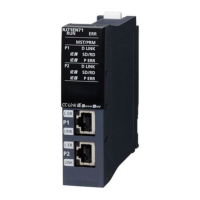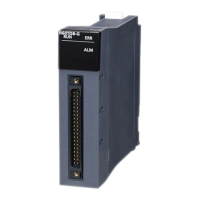438
31 POSITIONING INSTRUCTION
31.3 Mechanical OPR
Program example
The following is a program example of OPR operation (axis 1).
■Positioning parameter (high speed I/O parameter)
Item Axis 1 Item Axis 1
■Basic Parameter 1 ■Detailed Setting Parameter
Pulse Output Mode 1: PULSE/SIGN External Start Signal Enabled/
Disabled
0: Disabled
Output Device (PULSE/CW) Y0 Interrupt Input Signal 1 Enabled/
Disabled
0: Disabled
Output Device (SIGN/CCW) Y4 Interrupt Input Signal 2 Logic 0: Positive Logic
Rotation Direction Setting 0: Current Address Increment with Forward
Run Pulse Output
■OPR Parameter
Unit Setting 0: Motor System (pulse, pps) OPR Enabled/Disabled 1: Enabled
No. of Pulse per Rotation 2000 pulse OPR Direction 0: Negative Direction (Address
Decrement Direction)
Movement Amount per Rotation 1000 pulse Starting Point Address 0 pulse
Position Data Magnification 1: Single Clear Signal Output Enabled/
Disabled
1: Enabled
■Basic Parameter 2 Clear Signal Output Device No. Y1
Interpolation Speed Specified
Method
0: Composite Speed OPR Dwell Time 100 ms
Max. Speed 10000 pps Near-point Dog Signal Device No. X0
Bias Speed 1000 pps Near-point Dog Signal Logic 0: Positive Logic
Acceleration Time 500 ms Zero Signal Device No. X1
Deceleration Time 800 ms Zero Signal Logic 0: Positive Logic
Zero Signal OPR Zero Signal
Counts
1
Zero Signal Count Start Time 0: Near-point Dog Latter Part
Speed
Near-point dog signal X0
(positive logic)
Instruction execution complete flag
M1
Clear signal Y1
Within 1 ms
Dwell time
(100ms)
Maximum speed
(10000 pps)
OPR speed
(10000 pps)
Bias speed
(1000 pps)
Creep speed
(1500 pps)
Time
Clear signal output time
(20 ms + 1 operation cycle (ms))
Zero signal X1 (positive logic)
OPR zero signal counts: 1
Count Start Time: Near-point dog
latter part
Zero signal is ignored until the rear end of the near point
dog is detected (ONOFF).
Acceleration time
(500 ms)
Deceleration time
(800 ms)

